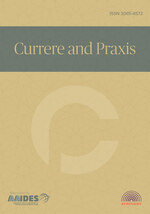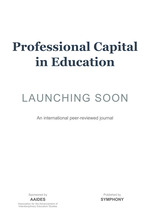Analyzing the success of Hispanic boys in meeting college and career readiness standards in rural Texas high schools
DOI:
https://doi.org/10.70116/2980274119Keywords:
College, career readiness, Hispanic, rural school districtAbstract
Examined in this investigation were the percentages of Hispanic boys who were college ready or not college ready as a function of the district’s rural setting for three consecutive school years (i.e., 2016-2017, 2017-2018, and 2018-2019). Descriptive statistics were calculated for all three rural school district types combined and then separately for the three rural school districts (i.e., Rural Remote, Rural Distant, and Rural Fringe). With respect to this investigation, 41% of Hispanic boys met a College, Career, and Military Readiness indicator in mathematics. All three rural school district types had positive trends or negligent changes over the three consecutive school years for Hispanic boys who met a College, Career, and Military Readiness indicator in mathematics. More than a third, 34.36%, of Hispanic boys from rural distant school districts met a college readiness indicator in mathematics. Similar percentages were present for Hispanic boys in rural remote school districts, 35.74%, and for Hispanic boys in rural fringe school districts, 36.01%. However, approximately two-thirds of Hispanic boys did not meet a college readiness indicator in mathematics in any of the three rural district type settings over three consecutive years. As such, educational leaders are encouraged to expand their efforts in this area, along with evaluating the efficacy of their current strategies.
Downloads
References
American College Testing. (2019). The condition of college & career readiness 2019. Retrieved July 11, 2022, from https://www.act.org/content/dam/act/unsecured/documents/National-CCCR-2019.pdf
Barnes, W., & Slate, J. R. (2014). College-readiness rates in Texas: A statewide, multiyear study of ethnic differences. Education and Urban Society, 46(1), 59-87. https://doi.org/10.1177/00131245114237
Bojorquez, H, (2018). Rural districts take a 24 percent hit in Algebra II enrollment. Intercultural Development Research Association, 45(5), 3-4. https://files.eric.ed.gov/fulltext/ED591756.pdf
Cha, S. (2015). Exploring disparities in taking high level math courses in public high schools. KEDI Journal of Educational Policy, 12(1), 3-17. http://eng.kedi.re.kr/
Conley, D. T. (2007). Refining college readiness. Educational policy improvement Center. Retrieved June 5, 2022, from https://files.eric.ed.gov/fulltext/ED539251.pdf
Cromartie, J., & Bucholtz, S. (2008). Defining the “Rural” in rural America. US Department of Agriculture. Retrieved August 29, 2022, from https://www.ers.usda.gov/amber-waves/2008/june/defining-the-rural-in-rural-america/
Edgerton, A. K., & Desimone, L. M. (2018). Teacher implementation of College- and Career-Readiness Standards: Links among policy, instruction, challenges, and resources. AERA Open, 4(4). https://doi.org/10.1177/2332858418806863
Field, A. (2009). Discovering statistics using SPSS (3rd ed.). Sage.
Field, K. (2021). The rise of dual credit. Higher Education, 21(1). https://www.educationnext.org/rise-dual-credit-more-students-take-college-classes-high-school-degree-attainment-rigor/
Fletcher, C., Cornett, A., & Webster, J. (2021). State of Student Aid and Higher Education in Texas. https://files.eric.ed.gov/fulltext/ED613370.pdf
Gagnon, D. J., & Mattingly, M. J. (2016). Advanced Placement and rural schools: Access, success, and exploring alternatives. Journal of Advanced Academics, 27(4), 266-284. https://doi.org/10.1177/1932202X16656390
Garcia, H. A., Eicke, D., McNaughtan, J., & Harwood, Y. (2020). Understanding dual credit programs: Perspectives from faculty, staff, and administrators. Community College Journal of Research and Practice, 44(8), 584-594. https://doi.org/10.1080/10668926.2019.1626301
Geverdt, D. (2015). Education Demographic and Geographic Estimates Program (EDGE): Locale Boundaries User’s Manual. U.S. Department of Education. Retrieved July 14, 2022, from http://nces.ed.gov/pubsearch
Hurtado, S., Ramos, H. V., Perez, E., & Lopez-Salgado, X. (2020). Latinx student assets, college readiness, and access: Are we making progress? Education Sciences, 10(4). https://link.gale.com/apps/doc/A630408736/AONE?u=anon~70904613&sid=googleScholar&xid=ab4544ef
Johnson, A. (2019). A matter of time: Variations in high school course-taking by years-as-EL subgroup. Educational Evaluation and Policy Analysis, 41(4), 461-482. https://doi.org/10.3102/0162373719867087
Johnson, P. N. (2018). Getting it just right! Rigor and collömbçege prep for all. Intercultural Development Research Association, 45(5), 1-2. https://files.eric.ed.gov/fulltext/ED591756.pdf
Johnson, R. B., & Christensen, L. (2020). Educational research: Quantitative, qualitative, and mixed approaches (7th ed.). Sage.
Kotok, S. (2017). Unfulfilled potential: High-achieving minority students and the high school achievement gap in math. The High School Journal, 100(3), 183-202. doi:10.1353/hsj.2017.0007
Lochmiller, C. R., Sugimoto, T. J., Muller, P. A., & Williamson, S. E. (2016). Dual enrollment courses in Kentucky: High school students’ participation and completion rates. Retrieved June 1, 2022, from https://ies.ed.gov/ncee/rel/regions/appalachia/pdf/REL_2016137.pdf
Martinez, M. A., & Welton, A. D. (2014). Examining college opportunity structures for students of color at high- “Minority,” high-poverty secondary schools in Texas. Journal of School Leadership, 24(5), 800-841. https://doi.org/10.1177/105268461402400501
Morath, M. (2019). House Bill 3 Implementation: CCMR outcome bonus allowable expenses. Texas Education Agency. Retrieved July 10, 2022, from https://tea.texas.gov/sites/default/files/House-Bill-3-HB-3-Implementation-CCMR-Outcomes-Bonus-Allowable-Expenses.pdf
National Center for Education Statistics. (2019). Indicator 19: College participation rates. Retrieved August 15, 2022, from https://nces.ed.gov/programs/raceindicators/indicator_rea.asp
Renbarger, R., & Long, K. (2019). Interventions for postsecondary success for low-income and high potential students: A systemic review. Journal of Advancement Academics, 30(2), 178-202. https://doi.org/10.1177%2F1932202X19828744
Rivera, S., Knack, J. M., Kavanagh, K., Thomas, J., Small, M. M., & Ramsdell, M. (2019). Building a STEM mentoring program in an economically disadvantaged rural community. Journal of Educational Research and Practice, 9(1), 413-422. https://files.eric.ed.gov/fulltext/EJ1278133.pdf
Showalter, D., Hartman, S. I., Johnson, J., & Klein, B. (2019). Why rural matters 2018-2019. Rural School and Community Trust. https://files.eric.ed.gov/fulltext/ED604580.pdf
Slate, J. R. (2023). Communicating your statistical findings in a formal and scholarly way: A guide for graduate students, faculty, and educational leaders. ICPEL Publications. International Council of Professors of Educational Leadership. https://www.lulu.com/shop/john-slate/communicating-your-statistical-findings-in-a-formal-and-scholarly-way-a-guide-for-graduate-students-faculty-and-educational/paperback/product-vprd8v.html
Taie, S., & Lewis, L. (2020). Dual or concurrent enrollment in public schools in the United States. National Center for Education Statistics. Retrieved July 10, 2022, from https://nces.ed.gov/pubs2020/2020125.pdf
Taylor, J., & Lichtenberger, E. (2013). Who has access to dual credit in Illinois? Examining high school characteristics and dual credit participation rates. Illinois Education Research Council, 4, 1-20. https://files.eric.ed.gov/fulltext/ED555454.pdf
Texas Education Agency. (2019). District Type Glossary of Terms, 2017-2018. Retrieved June 1, 2022, from https://tea.texas.gov/reports-and-data/school-data/district-type-data-search/district-type-glossary-of-terms-2017-18#teadist
Texas Education Agency. (2021). The TSIA (Texas Success Initiative Assessment). https://tea.texas.gov/academics/college-career-and-military-prep/the-tsia-texas-success-initiative-assessment
U. S. Constitution. (1789). Bill of rights. Retrieved July 7, 2022, from https://www.senate.gov/about/origins-foundations/senate-and-constitution/constitution.htm
United States Census. (n.d.). 2020 Census. Retrieved July 3, 2022, from https://www.census.gov/programs-surveys/decennial-census/decade/2020/2020-census-main.html
Warne, R. (2017). Research on the academic benefits of the Advanced Placement program: Taking stock and looking forward. Sage, 7(1), 1-16. https://doi.org/10.1177/2158244016682996
Witenko, V., Mireles-Rios, R., & Rios, V. (2017). Networks of encouragement: Who’s encouraging Latina/o students and White students to enroll in Honors and Advanced-Placement (AP) Courses? Journal of Latinos and Education, 16(3), 176-191. https://www.tandfonline.com/doi/full/10.1080/15348431.2016.1229612
Downloads
Published
How to Cite
Issue
Section
License
Copyright (c) 2024 Symphony

This work is licensed under a Creative Commons Attribution 4.0 International License.














